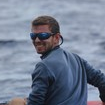Anthropogenic Impacts on Marine Ecosystems: A Biodiversity Conservation Emergency
A special issue of Diversity (ISSN 1424-2818). This special issue belongs to the section "Biodiversity Conservation".
Deadline for manuscript submissions: 31 October 2024 | Viewed by 4204
Special Issue Editors
Interests: marine pollution; natural pollution; ecotoxicology; marine biology; marine ecology
Interests: biodiversity; conservation; bioacoustics; marine ecology; ecology and evolution; animal behaviour
Special Issue Information
Dear Colleagues,
Marine biodiversity is being affected by human impacts worldwide. Microplastics, heavy metals and other toxics are constantly being poured into the ocean, and these substances are being incorporated and bioaccumulated by marine organisms, affecting the whole trophic web, with consequences at all ecosystem levels. Another anthropogenic effect on marine biodiversity derives from the increasing human activity in our seas, e.g., manmade powerful noises are disturbing the daily activity of vocal animals, from fish to cetaceans, and even producing malformations in invertebrate larvae, along with abnormal behaviours in different organisms. All of these anthropogenic impacts on the marine biota must be adequately evaluated and monitored, and conservation and decontamination measures must be proposed to regional and state governments to take action against the worrying loss of marine biodiversity.
With this Special Issue, we aim to offer an opportunity to present to the scientific community different cases of human impacts on marine ecosystems, from discrete effects on a single species to generalized effects in the whole trophic web and/or ecosystem. We encourage the prospective use of papers from this Special Issue to be used to support reports presented to competent authorities from each region in order to take action to preserve the marine environment.
Dr. Enrique Lozano
Dr. Jesús Alcázar-Treviño
Guest Editors
Manuscript Submission Information
Manuscripts should be submitted online at www.mdpi.com by registering and logging in to this website. Once you are registered, click here to go to the submission form. Manuscripts can be submitted until the deadline. All submissions that pass pre-check are peer-reviewed. Accepted papers will be published continuously in the journal (as soon as accepted) and will be listed together on the special issue website. Research articles, review articles as well as short communications are invited. For planned papers, a title and short abstract (about 100 words) can be sent to the Editorial Office for announcement on this website.
Submitted manuscripts should not have been published previously, nor be under consideration for publication elsewhere (except conference proceedings papers). All manuscripts are thoroughly refereed through a single-blind peer-review process. A guide for authors and other relevant information for submission of manuscripts is available on the Instructions for Authors page. Diversity is an international peer-reviewed open access monthly journal published by MDPI.
Please visit the Instructions for Authors page before submitting a manuscript. The Article Processing Charge (APC) for publication in this open access journal is 2600 CHF (Swiss Francs). Submitted papers should be well formatted and use good English. Authors may use MDPI's English editing service prior to publication or during author revisions.
Keywords
- marine pollution
- anthropogenic impacts
- marine biodiversity
- conservation threats
- plastic pollution
- heavy metals and trace elements
- acoustic pollution






